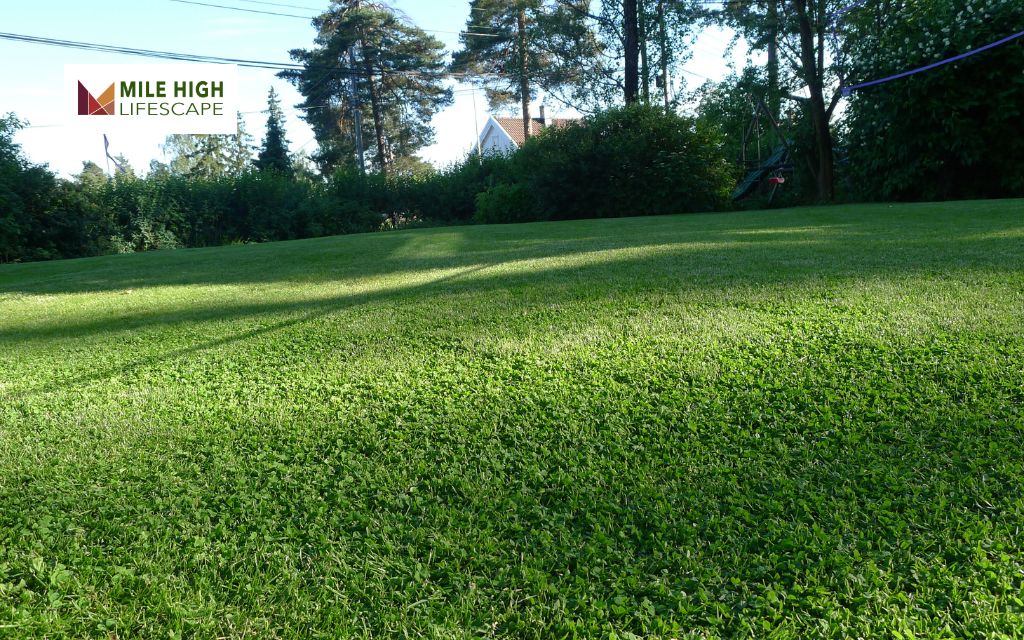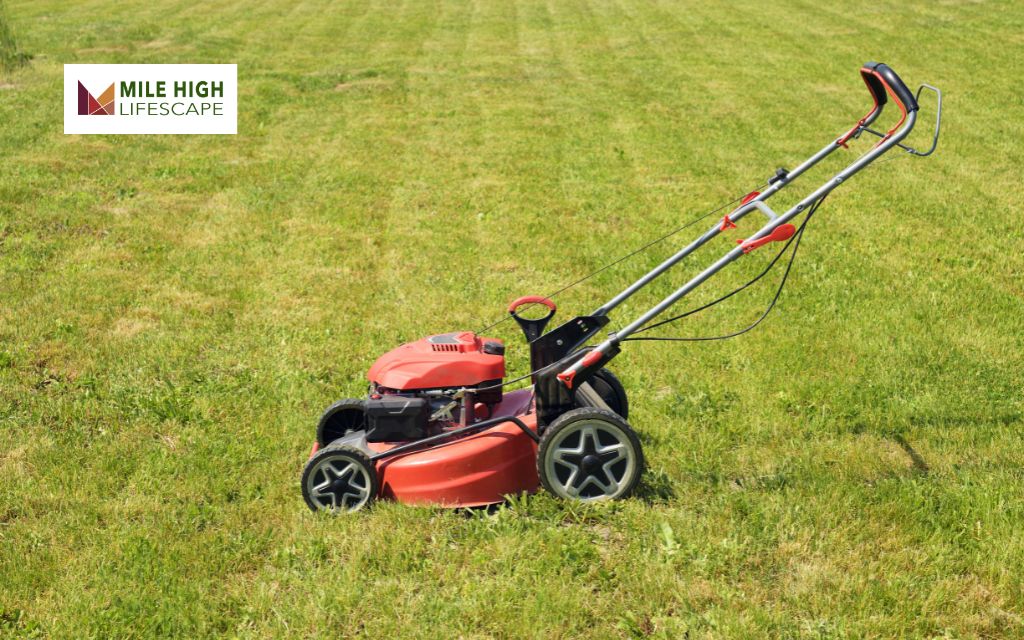A lush, green lawn doesn’t just happen – it requires proper care, and one of the most important factors is mowing frequency. Knowing how often to mow lawn is essential for maintaining thick, healthy grass while preventing issues like scalping, stress, or overgrowth. Mow too often, and you risk weakening your lawn; mow too little, and your grass can become overgrown and patchy.
The ideal mowing schedule depends on several factors, including grass type, season, and overall lawn conditions. In this article, we’ll break down the best mowing frequency for different lawns, ensuring your yard stays in top shape year-round.
For Denver homeowners looking for expert lawn care, Mile High Lifescape is the trusted name in professional tree and lawn care, offering reliable mowing services to keep your grass looking pristine. Ready to find the perfect mowing routine for your lawn? Let’s get started!
5 Factors That Affect How Often to Mow Lawn
Mowing your lawn is one of the easiest ways to take care of it, but there’s more to it than just pushing the mower around. To get the best results, you need to pay attention to how often to mow lawn, how short or long you cut the grass, and other important details.
How often you should mow your lawn depends on several things. Here are 6 factors to help you figure out the best way to mow and keep your lawn healthy.
Sunlight
Sunlight plays a big role in how well grass grows. The more sunlight your lawn gets, the faster it will grow. Some parts of your lawn might be in the shade from trees, fences, or even your house, and these areas grow slower because they don’t get as much sunlight. In those shaded areas, you’ll need to mow less often than the sunny spots where the grass grows faster.
Grass Type
There’s no one-size-fits-all answer for how tall your grass should be before mowing, because different types of grass grow in different ways.
For example, grass with shorter roots, like the kind you see on golf courses, should be kept shorter and mowed more often. Grass that grows taller, like wildflower lawns, can grow up to 4 inches before it needs to be cut. To know how often to mow your lawn, it’s important to first figure out what type of grass you have.
Grass Height
While it might seem like mowing your grass as short as possible would mean less work, it’s actually not good for your lawn. Grass needs to be a certain height to grow strong roots, and cutting it too short can harm it by making it harder for the grass to get water and nutrients.
On the other hand, letting your grass grow too high can invite weeds and pests. Here are the best mowing heights for some common types of grass:
- Bentgrass: ¼ to 1 inch
- Bermuda Grass: Regular – ¾ to 1 ½ inch; Hybrid – ½ to 1 inch
- Blue Grama Grass: 2 to 3 inches
- Buffalo Grass: 2 to 3 inches
- Centipede Grass: 1 to 2 inches
- Fescue: Tall – 2 to 3 inches; Fine – 1 ½ to 2 ½ inches
- Kentucky Bluegrass: 1 ¾ to 2 ½ inches
- Ryegrass (Annual or Perennial): 1 ½ to 2 inches
- Zoysia Grass: 1 to 2 inches
Growth Rate
Grass grows at different speeds depending on its type. Factors like watering, fertilizing, and how much rain your area gets can make the grass grow faster. The more you water and fertilize, the quicker your grass will grow, meaning you’ll have to mow more often.
In general, you only need to water your lawn once a week during the growing season. If your grass grows slowly, watering once every two weeks should be enough.

Time of Year and Climate
The weather also plays a big role in how often you should mow your lawn. In hot climates, grass grows faster, so you’ll need to mow more often. But in cooler areas, grass grows slower, and you can mow less frequently.
The type of grass you have matters too. Warm-season grasses grow best in the heat and should be mowed when they reach about 2 inches. Cool-season grasses grow better in colder weather and can grow up to 3 inches before needing a trim.
General Guidelines on How Often to Mow Your Lawn
Mowing your lawn at the right time is key to keeping it healthy and looking great. How often to mow lawn depends on the season, the type of grass you have, and how fast it’s growing. Sticking to a good mowing routine helps keep your lawn strong and avoids putting too much stress on the grass.
Spring Mowing Schedule
In spring, as the weather warms up, your grass will start to grow faster. It’s a good idea to mow every 5-7 days to keep the grass at a good height. Be sure to follow the one-third rule: don’t cut more than one-third of the grass at once. Regular mowing in the spring helps your lawn get ready for the summer heat.
Summer Mowing Schedule
In summer, how often to mow your lawn depends on how fast the grass is growing and the weather. Warm-season grasses, which grow quickly in the heat, need mowing every 4-7 days.
But if it’s super hot or there’s a drought, mowing too often can stress the lawn. To help the grass handle the heat better, raise the mower blade a little to keep the grass taller, which helps it stay strong and conserve moisture.
Fall Mowing Schedule
As it gets cooler in the fall, grass grows more slowly. You can mow less often, about every 7-10 days. This helps your lawn prepare for the cold winter months. Fall is also a great time to aerate, overseed, and fertilize the lawn to help it grow strong roots before winter.
Winter Mowing Schedule
In most places, you don’t need to mow in the winter since the grass is mostly dormant. However, in warmer areas where the grass still grows a bit, you might need to mow every 2-4 weeks to keep it even. Just make sure not to mow when the ground is frozen or too wet, as that can damage your lawn.

The One-Third Rule: How Short Should You Cut Grass?
A good rule to follow when mowing your lawn is the one-third rule. This means you should never cut more than one-third of the grass height in a single mowing session. Cutting too much at once can shock the grass and hurt its health.
If your grass has grown too tall, it’s best to mow it in steps. Mow a third of the height each week until it reaches the desired length. This keeps your lawn healthy and helps it bounce back better.
Common Mistakes to Avoid When Mowing
Many people think that cutting the lawn really short will save time because it means mowing less often. But this is actually a mistake.
When you cut the grass too short, it can harm the plants. By removing too much of the grass, you’re taking away the leaves that help the grass make food through sunlight. Without enough leaves, the grass can’t grow strong roots, and it becomes weaker, which makes it more likely to suffer from heat, drought, or pests.

Also, cutting the grass too short opens up space for weeds to grow. Another mistake is waiting too long between mowing sessions. Both cutting too short and waiting too long go against the “one-third rule,” which helps keep the lawn healthy.
The best way to maintain a great lawn and reduce how often to mow lawn is by keeping the grass at a good height and only cutting about one-third of the grass blade each time. This keeps your lawn strong and can actually reduce how often you need to mow.
Tips for Maintaining a Healthy Lawn with Proper Mowing
Taking care of your lawn doesn’t have to be difficult. There are a few easy things you can do that will make a big difference in how your lawn looks and how healthy it stays.
Keep Mower Blades Sharp
It’s really important to keep your mower blades sharp. When blades are dull, they tear the grass instead of cutting it cleanly. This leaves the grass looking ragged and makes it more likely to turn brown and get sick.
Leave Clippings in Place
Instead of bagging up the grass clippings, leave them on the lawn. These clippings are full of nutrients that help feed the grass and keep your lawn healthy. Plus, it saves you time and effort!
Don’t Mow Wet Grass
It’s best to avoid mowing when the grass is wet. Wet grass can get stuck in your mower and leave clumps all over the lawn. Plus, wet conditions can spread diseases to your grass.
Avoid Compaction
Change your mowing direction every time you mow to prevent damaging the soil. If you have to turn your mower, try to turn on hard surfaces like the driveway or sidewalk. When you do need to turn on the lawn, do it slowly and gently to avoid hurting the grass.

FAQs about How Often To Mow Lawn
Should I Mow More Often in the Growing Season?
Yes, during the growing season, it’s a good idea to mow more often. Mowing regularly helps your grass grow strong and thick, which keeps weeds away.
How often you mow depends on how fast your grass grows, which can change based on the type of grass, the weather, and the time of year. A good rule to follow is the one-third rule—never cut more than a third of the grass length at once. This helps keep your lawn healthy and happy.
What Happens If I Don’t Mow Regularly?
If you don’t mow your lawn regularly, the grass can get too long. This leads to problems like thick thatch, pests, diseases, and an uneven lawn. Overgrown grass can even block sunlight from reaching other grass blades, which slows down the grass’s growth and makes the lawn weaker.
Can I Mow Wet Grass?
It’s best not to mow when the grass is wet. Wet grass can lead to fungal diseases in the plants, damage the soil, and even cause accidents while mowing. It’s safer and better for your lawn to wait until the grass is dry before mowing.
Conclusion
Knowing how often to mow lawn is key to keeping it lush and healthy. By following the one-third rule, adjusting your mowing schedule by season, and keeping your mower blades sharp, you’ll prevent common lawn problems and promote strong, green grass. Regular mowing at the right height helps reduce weeds, improve root growth, and enhance curb appeal. Stick to a good routine, and your lawn will reward you with a fresh, well-maintained look all year long!
